Have you ever wondered how much power (watts) your pellet stove uses, or how much energy (kWh) it consumes, or how much it actually costs you on your electric bill to run it for the season? I measured the electricity consumption of several pellet stoves with a P3 Kill A Watt meter and found they average between about 125 Watts to 150 Watts instantaneous power draw depending on the auger and blower settings.
Here's some actual numbers from a 20+ year old Whitfield Advantage II T Insert. During the monitoring period of approximately 2 weeks the stove was running 24 hours a day, only being shutdown for routine cleanings, with the auger and blower speeds being adjusted as usual by the user.
Instantaneous Measurements:
Stove Settings: Auger = 2, Blower = 3
Auger Off Auger Feeding
76 Watts 100 Watts
1.33 Amps 1.71 Amps
159 Volt Amps 197 Volt Amps
.48 Power Factor .48 Power Factor
Electric Rate: 19.1 cents/kWh (Townsend, MA)
Elapsed Time 353 hours (14 days, 17 hours)
kWh's used: 29.81
Total Cost: $ 5.69 (29.81 kWh x .191 = $5.69)
Projected Costs to run stove
6 Months $70.00
1 Month $11.55
1 Week $ 2.69
1 Day $ 0.38
Based on the measurements above I could estimate that this stove uses approximately 2 kWh per day or 60 kWh per month the way the user runs it. Many articles I have read estimate about 100 kWh per month for pellet stoves, which is an acceptible number, but probably a little high.
Surprisingly, my brand new 2010 Harman P35i uses slightly more electricity than the older Whitfield (125 Watts - Auger Off, 150 Watts Auger On), and most notably consumes a significantly higher amount (395 Watts) when using the electric heating element for the auto igniter, but only for about 6.5 minutes when starting the fire. This does not really add a significant cost to the overall electricity consumption however. Here's an example:
395 W x 1 hr = 395 Watt Hours (That's about .4 kWh for roughly 10 fires - 1 hr / 6.5 minutes)
So for every 20 fires, (about 20 days at 1 fire a day) it uses an extra 1kWh to use the auto igniter, which for me costs 19.1 cents - fairly insignificant. I am currently monitoring the Harman P35i, and will post an update when I get some long term readings on its energy consumption.
The Whitfield stove above does not have the auto igniter feature.
Finally, I can say that I have seen a significant reduction in my electric bill by using the pellet stove, as opposed to my forced hot air oil fired furnace. So the pellet stove is saving me $$$ on both heating fuel costs and my electric bill! Awesome
Does anyone else have any measurements on other pellet stoves? I'd be curious to see how they compare to these two.
FYI Here's a link to the P3 Kill A Watt EZ meter I use on Amazon.com
http://www.amazon.com/P3-Internatio...F29Q/ref=sr_1_1?ie=UTF8&qid=1296438867&sr=8-1
Here's some actual numbers from a 20+ year old Whitfield Advantage II T Insert. During the monitoring period of approximately 2 weeks the stove was running 24 hours a day, only being shutdown for routine cleanings, with the auger and blower speeds being adjusted as usual by the user.
Instantaneous Measurements:
Stove Settings: Auger = 2, Blower = 3
Auger Off Auger Feeding
76 Watts 100 Watts
1.33 Amps 1.71 Amps
159 Volt Amps 197 Volt Amps
.48 Power Factor .48 Power Factor
Electric Rate: 19.1 cents/kWh (Townsend, MA)
Elapsed Time 353 hours (14 days, 17 hours)
kWh's used: 29.81
Total Cost: $ 5.69 (29.81 kWh x .191 = $5.69)
Projected Costs to run stove
6 Months $70.00
1 Month $11.55
1 Week $ 2.69
1 Day $ 0.38
Based on the measurements above I could estimate that this stove uses approximately 2 kWh per day or 60 kWh per month the way the user runs it. Many articles I have read estimate about 100 kWh per month for pellet stoves, which is an acceptible number, but probably a little high.
Surprisingly, my brand new 2010 Harman P35i uses slightly more electricity than the older Whitfield (125 Watts - Auger Off, 150 Watts Auger On), and most notably consumes a significantly higher amount (395 Watts) when using the electric heating element for the auto igniter, but only for about 6.5 minutes when starting the fire. This does not really add a significant cost to the overall electricity consumption however. Here's an example:
395 W x 1 hr = 395 Watt Hours (That's about .4 kWh for roughly 10 fires - 1 hr / 6.5 minutes)
So for every 20 fires, (about 20 days at 1 fire a day) it uses an extra 1kWh to use the auto igniter, which for me costs 19.1 cents - fairly insignificant. I am currently monitoring the Harman P35i, and will post an update when I get some long term readings on its energy consumption.
The Whitfield stove above does not have the auto igniter feature.
Finally, I can say that I have seen a significant reduction in my electric bill by using the pellet stove, as opposed to my forced hot air oil fired furnace. So the pellet stove is saving me $$$ on both heating fuel costs and my electric bill! Awesome

Does anyone else have any measurements on other pellet stoves? I'd be curious to see how they compare to these two.
FYI Here's a link to the P3 Kill A Watt EZ meter I use on Amazon.com
http://www.amazon.com/P3-Internatio...F29Q/ref=sr_1_1?ie=UTF8&qid=1296438867&sr=8-1



 Unfortunately, I don't have a power meter - only a digital multimeter - so I can't correct and redo my calcuation.
Unfortunately, I don't have a power meter - only a digital multimeter - so I can't correct and redo my calcuation.